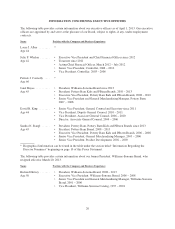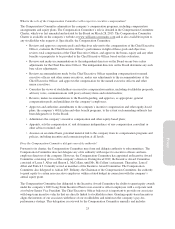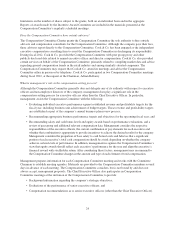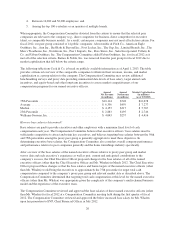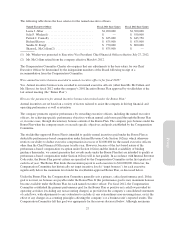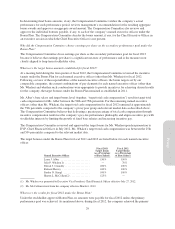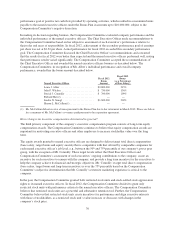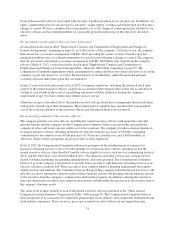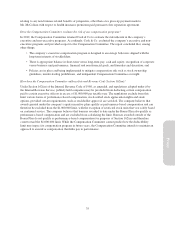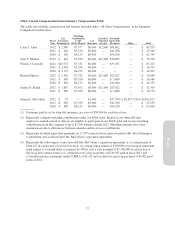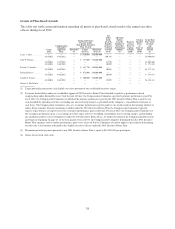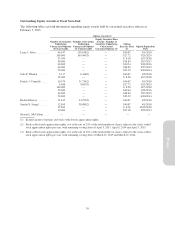Pottery Barn 2012 Annual Report Download - page 124
Download and view the complete annual report
Please find page 124 of the 2012 Pottery Barn annual report below. You can navigate through the pages in the report by either clicking on the pages listed below, or by using the keyword search tool below to find specific information within the annual report.
performance goal of positive net cash flow provided by operating activities, which resulted in a maximum bonus
payable to the named executive officers under the Bonus Plan in amounts up to $10,000,000, subject to the
Compensation Committee’s negative discretion.
In making its decision regarding bonuses, the Compensation Committee evaluated company performance and the
individual performance of the named executive officers. The Chief Executive Officer made recommendations to
the Compensation Committee based on her subjective assessment of each executive’s performance relative to
their roles and areas of responsibility. In fiscal 2012, achievement of the secondary performance goal of earnings
per share was set at $2.52 per share. Actual performance for fiscal 2012 exceeded this secondary performance
goal. The Compensation Committee discussed the Chief Executive Officer’s recommendations and concurred
that the results for fiscal 2012 were better than expected and the named executive officers performed well, noting
that performance results varied significantly. The Compensation Committee accepted the recommendations of
the Chief Executive Officer and awarded the named executive officers bonuses as described below. The
Compensation Committee, in recognition of Ms. Alber’s individual performance and overall company
performance, awarded her the bonus amount described below.
Named Executive Officer
Fiscal 2012
Bonus
Amount
Fiscal 2012
Bonus
(as a Percentage
of Base Salary)
Laura J. Alber ......................... $2,800,000 215%
Julie P. Whalen ........................ $ 750,000 136%
Patrick J. Connolly ..................... $ 700,000 109%
Richard Harvey ........................ — —
Sandra N. Stangl ....................... $1,600,000 200%
Sharon L. McCollam(1) .................. — —
(1) Ms. McCollam did not receive a bonus pursuant to the Bonus Plan due to her retirement in March 2012. Please see below
for a summary of Ms. McCollam’s severance paid pursuant to her separation agreement.
How is long-term incentive compensation determined in general?
The third primary component of the company’s executive compensation program consists of long-term equity
compensation awards. The Compensation Committee continues to believe that equity compensation awards are
important for motivating executive officers and other employees to increase stockholder value over the long
term.
The equity awards granted to named executive officers are designed to deliver target total direct compensation
(base salary, target bonus and equity awards) that is competitive with that offered by comparable companies for
each named executive officer’s job level, e.g., between the 50th and 75th percentile of our company’s proxy peer
group, with the exception of Mr. Connolly. These target levels reflect the Chief Executive Officer and
Compensation Committee’s assessment of such executives’ ongoing contributions to the company, create an
incentive for such executives to remain with the company, and provide a long term incentive for the executives to
help the company achieve its financial and strategic objectives. Mr. Connolly’s target total direct compensation
(base salary, target bonus and long-term incentives) is over the 75th percentile based on the Compensation
Committee’s subjective determination that Mr. Connolly’s extensive marketing experience is critical to the
company.
In the past, the Compensation Committee granted both restricted stock units and stock-settled stock appreciation
rights to its named executive officers. In fiscal 2012, the Compensation Committee decided to grant only
restricted stock units with performance criteria to the named executive officers. The Compensation Committee
believes that restricted stock units are a powerful and substantive retention tool. Further, the Compensation
Committee believes that restricted stock units create incentives for performance and align executive interests
with those of stockholders, as a restricted stock unit’s value increases or decreases with changes in the
company’s stock price.
30


